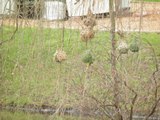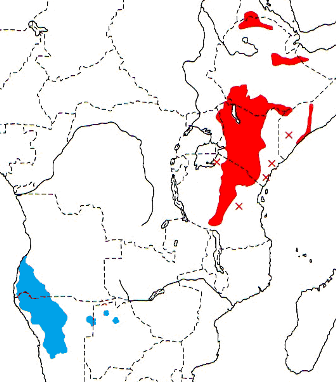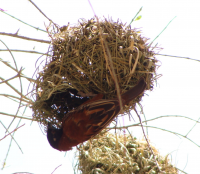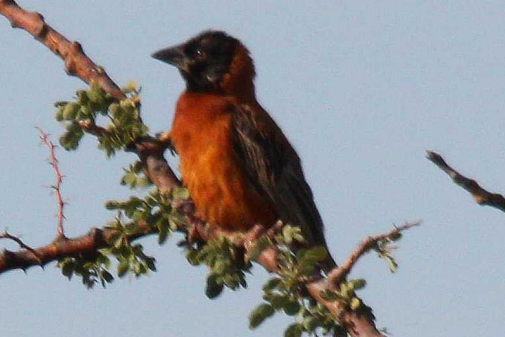Weaver species
Choose different species from drop-down list and press 'Go' button. See Full species list.Chestnut Weaver Ploceus rubiginosus
IUCN: Least concern Discovery: 044Categories: acacias, baobab, pest, Nest use,
News items about species
Discovery
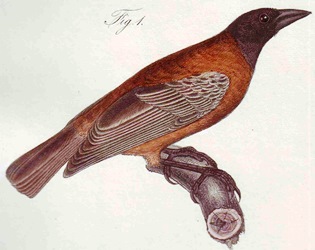
figure from Ruppell 1840 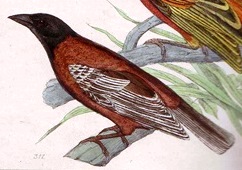
figure from Reichenbach 1863 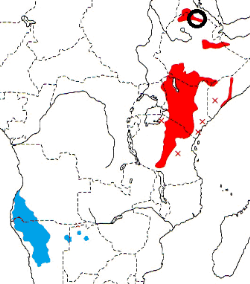
distribution, type locality circled IntroductionThe Chestnut Weaver was formally described by Wilhelm Peter Eduard Simon Rüppell, a German naturalist and explorer, especially in north-east Africa. Rüppell was the first naturalist to travel through Ethiopia and many birds are named after him.On Rüppell's third journey to Africa, in 1831-34, he travelled to the Sinai Peninsula, Egypt, and along the coast of the Red Sea to Massawa (Steinheimer 2005). Rüppell stayed in this area a few months at the end of 1831 and into early 1832, and then travelled inland with a trade caravan to reach the Abyssinian Highlands in 1833. He found the Chestnut Weaver at only one locality on his travels. The weavers were in small family parties at high altitude and he collected a male, female and young bird. The first illustration of a Chestnut Weaver is a colour painting in Ruppell 1840. The next illustration is by Reichenbach (1863), also of an adult male. Scientific citationPloceus rubiginosus Ruppell 1840 Neue Wirbelt., Vogel, p.93, 100; pl. 33, fig. 1; Temben province, northern Abyssinia.Meaning of namesrubiginosus - Latin: rusty, ferruginous.First English nameThe rufous Weawer (Reichenbach 1863).Alternate namesAngola Chestnut Weaver, Chocolate Weaver, The rufous Weawer.CollectorEduard Rüppell.Date collected1833.Locality collectedTemben province, northern Ethiopia.Type specimensOne specimen is known to be in the British Museum (Vell. Cat. XX:239 a) (Sharpe 1890) - this specimen was aquired from the Senckenberg Museum in Frankfurt in 1834. Senckenberg Museum has two additional syntypes, a male and a female (SMF 12645, 69062). |
The above is based on Weaver Wednesday 2, a weekly series about the discovery of each weaver species.
This species text first appeared as
Weaver Wednesday [161] - Discovery [44]: Chestnut Weaver on 2015-07-15
1. Basic biology

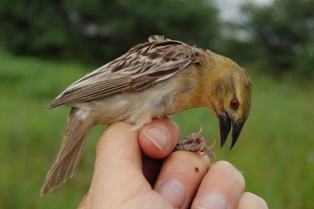
Identification. The Chestnut Weaver is named after its colour. The adult male (photo above left) in breeding plumage is a distinctive chestnut with a black head. There are 2 other chestnut coloured birds in Africa. The Cinnamon Weaver (see photo here) is similar but has yellow wing edges (rather than pale) and yellow vent (rather than brown as in the Chestnut Weaver). The Chestnut Sparrow Passer eminibey has chestnut wing edges and is smaller than the Chestnut Weaver. Female (photo above right) and non-breeding male Chestnut Weavers are much browner than other weavers, with buff or chestnut breast-band and flanks, and in southern Africa the grey bill is distinctive. Juveniles are similar but with streaked breasts (see photo here).
Distribution.
Two subspecies of the Chestnut Weaver are currently recognised (see map left, based on Birds of Africa):
There are vagrant records from southern Namibia and South Africa - see here) for a map and links to pdfs describing these records. Habitat. Chestnut Weavers inhabit dry thornveld. Food. The Chestnut Weaver feeds on grass seeds and also on insects. In East Africa it feeds mainly on wild grass seeds but switches to cereal crops (especially sorghum) in Feb-Apr, and thus being a pest. Non-breeding birds flock and roost with other granivores and may form large mixed roosts. Breeding. This species is monogamous and polygynous and highly colonial, with 500 or more nests covering trees in a small area (photo below left, from phown 3739). For example, following exceptional rains in Namibia, over 100 trees had 40-100 nests in each. Colonies are established at different sites every year, although sometimes the same sites are used again in Namibia. Breeding is fairly well-synchronized within a colony. Males are present during the nest-building phase, displaying with beating wings from their nests. Males leave the colony during the breeding cycle, often while the females are incubating. The males form nomadic flocks and start moult, leaving colonies occupied only by females and young birds.
The nest is built by the male of grass stems (photo right, from phown 2476). The nest is retort-shaped with a short spout (sometimes absent). Nests are usually suspended from the tip of branches, sometimes 3-4 nests hang in a string below one another or are clustered together. Nests look untidy, having protruding grass stems. The nest ceiling and floor are lined with grass heads. Females do all the incubation and feeding of young, since the males leave the colony early. Red-headed Finches and other species often nest in old nests, and Red-headed Finches also take over active nests. |
The above is based on Weaver Wednesday, a weekly series about weaver species.
This species text first appeared as
Weaver Wednesday [26]: Chestnut Weaver on 2012-12-12
2. Breeding facts
| Pair bond monogamous and polygynous Breeding season Oct in Ethiopia, May in Somalia, May-Jul in Uganda, Apr-Jul (also Nov in N arid region) in Kenya, Mar-Apr in Tanzania, Apr in Angola and Dec-May (mainly Jan-Mar) in Namibia Nest site generally suspended from tip of branch by cord of grass stems, sometimes several nests suspended one below another, 3-5 m above ground in large tree in open grassland, usually baobab (Adansonia) in Kenya and acacia (Acacia), Albizia or Colophospermum in Namibia Nest building tightly woven inside by male, lined with grass seedheads by female Colony size highly colonial, e.g. more than 100 trees each held 40-100 nests at site in Namibia Clutch size average 3 eggs (Namibia) Egg colour pale turquoise-blue, sometimes speckled or scrolled with dark green Egg size average size of 20 eggs 22.8 x 15.7 mm (Namibia) Incubation incubation by female, period 11-14 days, hatching staggered, suggesting that incubation starts when first egg laid Chicks and nestling period chicks fed by female only, as males have already left colony, nestling period 13-16 days |
Breeding information based on Handbook of the Birds of the World, Vol. 15.
3. Photos of Weaver Nests
 Vm 30866 | 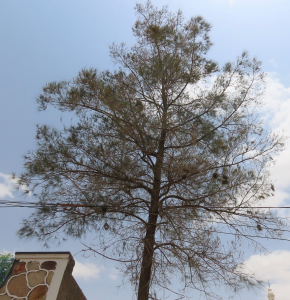 Vm 30855 |  Vm 30237 | 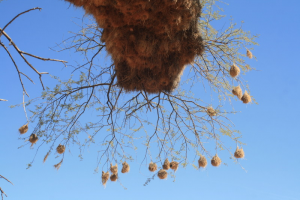 Vm 30016 |  Vm 29926 |  Vm 29820 |
Thumb-nails of most recent PHOWN records - click on one to see its full record
See all PHOWN records for this species here.
PHOWN (Photos of Weaver Nests) provides valuable info on breeding distribution and colony sizes of weavers.
You can contribute by registering and submitting photos at Virtual Museum webpage.
4. Breeding distribution
Google map showing distribution (For species with small ranges you need to zoom in at the correct area to see the range):
yellow blob - range of weaver species; read more about this here.
![]() - PHOWN records with photos
- PHOWN records with photos
![]() - PHOWN records with no photos (Nest Record Cards, other records)
- PHOWN records with no photos (Nest Record Cards, other records)
![]() - Birdpix records
- Birdpix records
![]() - comments on out of range records, or interesting records
- comments on out of range records, or interesting records
![]() - type locality
- type locality
CLICK on the marker on the map to see individual record details.
5. Range changes
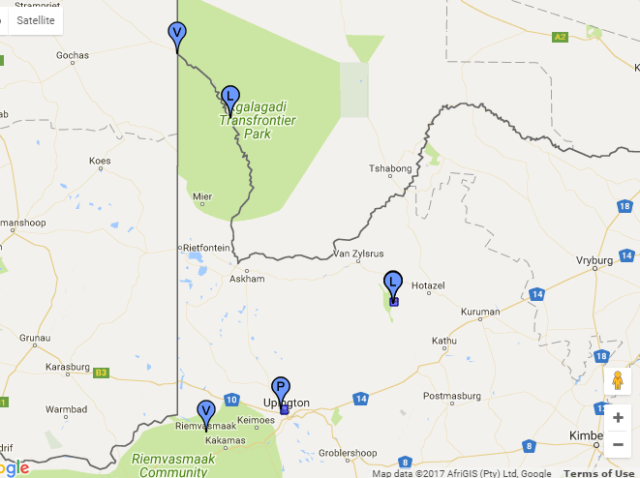
V=Virtual Museum record (Birdpix), P=PHOWN record, L=Literature record
Range changes in SAIn South Africa the Chestnut Weaver has two grid cells with records from SABAP2 (2007-), while there were no records during SABAP1 (1987-1991), nor previous to the atlas projects.There were also additional records, as listed in the Table below.
Table: records of Chestnut Weavers in the Northern Cape, South Africa
Notes:
Range changes elsewhereNamibia: sighting far south of its range in Namibia (Swanepoel W 2005 Birds on the move: range extensions and vagrants in western, central and southern Namibia 1994-2005. Lanioturdus 38(2):19-24). | |||||||||||||||||||||||||||||||||||||||||||||||||||||||||||||||||||||||||||||||||||||||||
The above is based on Weaver Wednesday 3, a weekly series about range changes in South African weaver species.
This species text first appeared as
Weaver Wednesday 3 [262] - Range changes [25]: Chestnut Weaver on 2017-06-21








